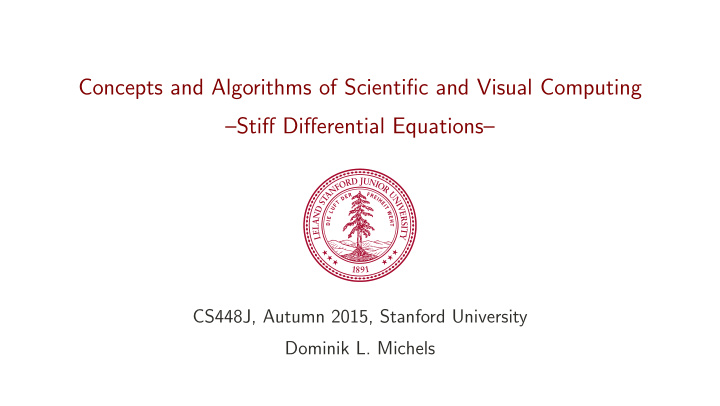



Concepts and Algorithms of Scientific and Visual Computing –Stiff Differential Equations– CS448J, Autumn 2015, Stanford University Dominik L. Michels
Stiff Cauchy Problems According to the Picard-Lindel¨ of theorem, the Cauchy problem d x ( y ( x )) = f ( x , y ( x )) with initial value y 0 ( x 0 ) = y 0 and Lipschitz continuity of f , i.e. | f ( x , y 1 ) − f ( x , y 2 ) | ≤ N | y 1 − y 2 | for all ( x , y 1 ) and ( x , y 2 ) in a neighborhood G of ( x 0 , y 0 ) has a unique local solution. If the constant N takes high values, although the solution y runs smoothly, explicit integration methods have to take very small step sizes in order to approximate y appropriately. Such a scenario is called a stiff Cauchy problem.
Stiff Cauchy Problems According to the classical definition of [Curtiss 1952] the term “stiff” means: “...where certain implicit methods perform better than explicit ones”. Stiffness as such is not a characteristic of the differential equations nor is it a property of the numerical methods applied in order to solve them. It is just an issue of efficiency because we want a numerical integration method to sample the important time scales as quickly as possible.
Dahlquist Equation According to [Dahlquist 1963] we consider the differential equation d t ( y ( x )) = f ( y ( x )) , y (0) = y 0 with f ( y ( x )) = − λ y ( x ) and λ ∈ R > 0 , and its analytical solution y ( x ) = exp( − x λ ) y 0 . We apply the explicit and the implicit Euler method so that we obtain the scheme y ( x + ∆ x ) = (1 − ∆ x λ ) y ( x ) for the explicit case and 1 y ( x + ∆ x ) = 1 + ∆ x λ y ( t ) for the implicit case.
Dahlquist Equation The absolute value of the exact solution is decreasing monotonically. Hence | 1 − ∆ x λ | ≤ 1 is a necessary criterion for the convergence of the explicit Euler method. The analogous criterion for the implicit method is given by � � 1 � � � ≤ 1 . � � � 1 + ∆ x λ � � The first condition is only fulfilled for small step sizes ∆ x , whereas the second one is fulfilled for all ∆ x > 0.
Semi-analytical Exponential Integrator We consider the symplectic construction of a so-called semi-analytical exponential integrator for second-order differential equations of motion. x + Ax = g ( x ) ¨ ↓ � � ( n +1) ∆ t √ � � g ( x ( t )) d t 2 x n +1 ← 2cos ∆ t A x n − x n − 1 + n ∆ t √ √ √ x n − x n − 1 + ∆ t 2 ψ � � � � � � � � ≈ 2cos ∆ t A ∆ t A g φ ∆ t A x n ↓ ( x n − 1 , x n ) �→ ( x n , x n +1 ) Φ ∆ t : ( x n , v n ) �→ ( x n +1 , v n +1 ) � ↓ Φ ∆ t symplectic, iff ψ ( · ) = sinc( · ) φ ( · ) ( ψ,φ ) = (sinc 2 , sinc) �
Semi-analytical Exponential Integrator Finally we obtain the so-called exponential integrator of Gautschi type, see [Gautschi 1961]. ¨ x + Ax = g ( x ) ↓ √ √ √ � � x n − x n − 1 + ∆ t 2 sinc 2 � � � � � � x n +1 = 2cos ∆ t A ∆ t A g sinc ∆ t A x n This is a composition of a partial analytical solution and a low-pass filtered nonlinearity leading to an explicit, symplectic, and time-reversible scheme of second order.
Splitting / Variational Implicit-explicit Integrator Splitting of the potential into a fast (i.e. highly oscillatory) and a slow component is often possible. Based on this observation the midpoint quadrature rule is applied to a fast quadratic potential and the trapezoidal quadrature rule to the remaining slow potential term resulting in Λ . The application of the discrete Euler-Lagrange formalism leads to the so-called variational implicit-explicit integrator which takes the form � − 1 ( Kx n + Λ ( x n )) . x n +1 = 2 x n − x n − 1 − ∆ t 2 � 1 + ∆ t 2 / 4 K Since it is based on a discrete variational principle, it is naturally symplectic. Moreover, its symmetry can be followed easily by calculation.
Recommend
More recommend